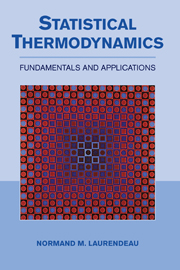Book contents
- Frontmatter
- Contents
- Preface
- 1 Introduction
- PART ONE FUNDAMENTALS OF STATISTICAL THERMODYNAMICS
- PART TWO QUANTUM MECHANICS AND SPECTROSCOPY
- PART THREE STATISTICAL THERMODYNAMICS IN THE DILUTE LIMIT
- PART FOUR STATISTICAL THERMODYNAMICS BEYOND THE DILUTE LIMIT
- PART FIVE NONEQUILIBRIUM STATISTICAL THERMODYNAMICS
- PART SIX THE ENSEMBLE METHOD OF STATISTICAL THERMODYNAMICS
- PART SEVEN APPENDICES
- Index
1 - Introduction
Published online by Cambridge University Press: 05 June 2012
- Frontmatter
- Contents
- Preface
- 1 Introduction
- PART ONE FUNDAMENTALS OF STATISTICAL THERMODYNAMICS
- PART TWO QUANTUM MECHANICS AND SPECTROSCOPY
- PART THREE STATISTICAL THERMODYNAMICS IN THE DILUTE LIMIT
- PART FOUR STATISTICAL THERMODYNAMICS BEYOND THE DILUTE LIMIT
- PART FIVE NONEQUILIBRIUM STATISTICAL THERMODYNAMICS
- PART SIX THE ENSEMBLE METHOD OF STATISTICAL THERMODYNAMICS
- PART SEVEN APPENDICES
- Index
Summary
To this point in your career, you have probably dealt almost exclusively with the behavior of macroscopic systems, either from a scientific or engineering viewpoint. Examples of such systems might include a piston–cylinder assembly, a heat exchanger, or a battery. Typically, the analysis of macroscopic systems uses conservation or field equations related to classical mechanics, thermodynamics, or electromagnetics. In this book, our focus is on thermal devices, as usually described by thermodynamics, fluid mechanics, and heat transfer. For such devices, first-order calculations often employ a series of simple thermodynamic analyses. Nevertheless, you should understand that classical thermodynamics is inherently limited in its ability to explain the behavior of even the simplest thermodynamic system. The reason for this deficiency rests with its inadequate treatment of the atomic behavior underlying the gaseous, liquid, or solid states of matter. Without proper consideration of constituent microscopic systems, such as a single atom or molecule, it is impossible for the practitioner to understand fully the evaluation of thermodynamic properties, the meaning of thermodynamic equilibrium, or the influence of temperature on transport properties such as the thermal conductivity or viscosity. Developing this elementary viewpoint is the purpose of a course in statistical thermodynamics. As you will see, such fundamental understanding is also the basis for creative applications of classical thermodynamics to macroscopic devices.
The Statistical Foundation of Classical Thermodynamics
Since a typical thermodynamic system is composed of an assembly of atoms or molecules, we can surely presume that its macroscopic behavior can be expressed in terms of the microscopic properties of its constituent particles.
- Type
- Chapter
- Information
- Statistical ThermodynamicsFundamentals and Applications, pp. 1 - 4Publisher: Cambridge University PressPrint publication year: 2005



